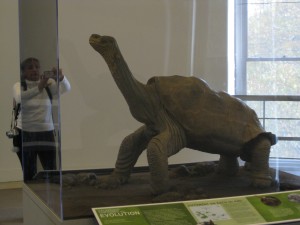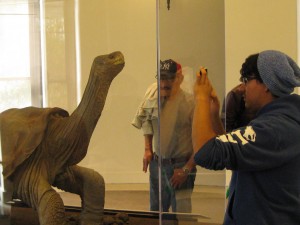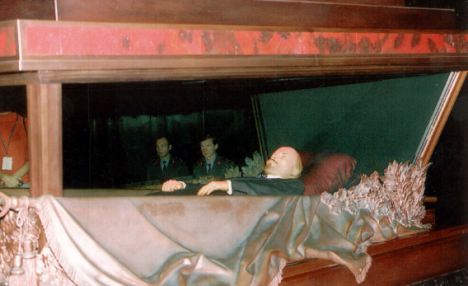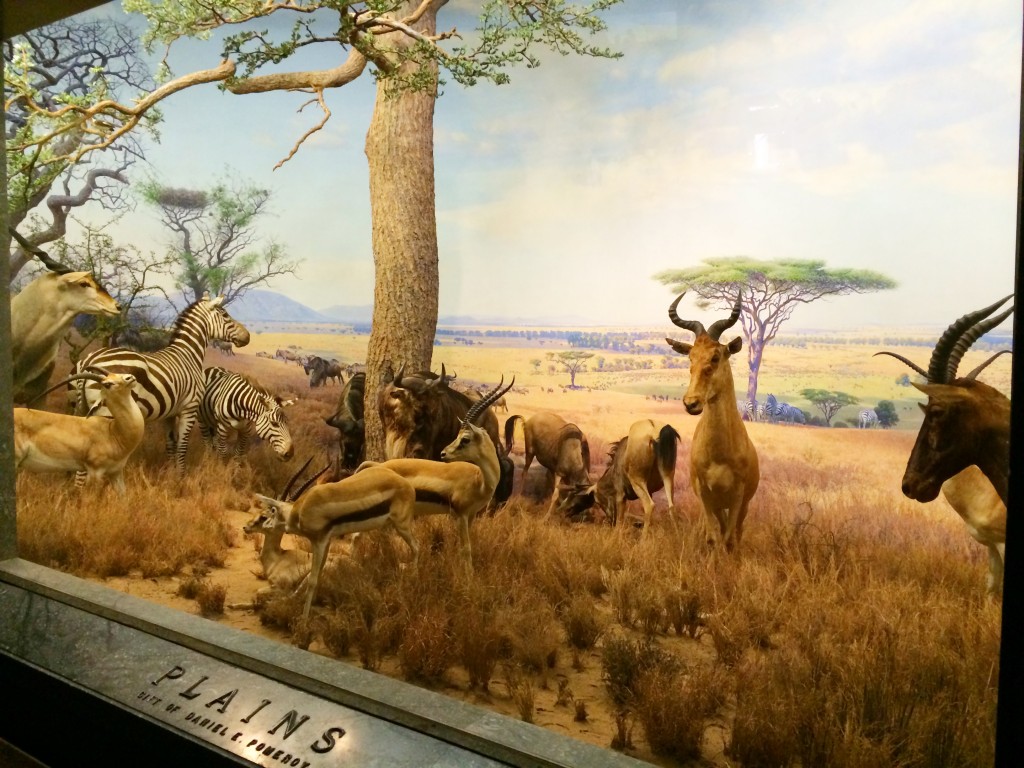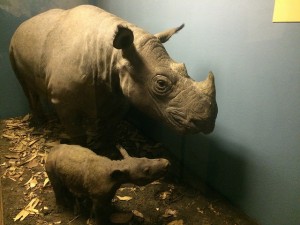George? Who were you George?
I’m standing beside a plexiglass vitrine at the American Museum of Natural History. In it are the taxidermied remains of George, the last Pinta Island Galapagos tortoise, who died suddenly on June 24th 2012, of so called ‘natural causes.’ At the time of his death, George was estimated to be about 100 years old – a spring chicken by tortoise standards, and sadly he passed away without carrying on his illustrious line. All other members of his Chelonoidis nigra abingdoni subspecies predeceased him, their once considerable numbers decimated by passing sailors who hunted them down as easy to catch and easy to store meat that could be kept alive in the holds of their ships for months. The few Pinta tortoises the sailors missed mostly starved to death after goats got introduced to Pinta in 1959, which then stripped away the vegetation they needed for food and cover. How George survived alone, until he was discovered when he came out of hiding in 1971, is still a bit of a mystery but he was soon shipped off to the Charles Darwin Research Station on nearby Santa Cruz in the hopes he might mate with females of a related subspecies and perhaps sire hybrid offspring to make situation of his genetic extinguishment a little less final. But it was not to be and George during the years of his confinement remained something of a sad curiosity, the embodiment of a ‘zombie species,’ still scrabbling around but already functionally extinct.
When George died in his enclosure, his head pointing poignantly in the direction of his drinking pool, his remains were promptly frozen and shipped off to the AMNH where he was set upon by a crack team of embalmers, who (it has to be said) did an amazing job making them look almost perky. The AMNH produced an informative video documenting the taxidermist’s macabre prestidigitations; the agonizing decision making of choosing the appropriate pose, getting the correct drape of his wrinkly skin right, the touchings up with paints and varnishes, the fastidious attention to detail neccessitating even splotches of authentic Galapagos dust to be daubed onto George’s eviscerated carapace.
In his temporary mausoleum in the museum’s Astor Turret, George draws quite a crowd and he rather gives the impression of a reptilian Lenin, serene beneath the glass of his tomb, while crowds of supplicants stream by to pay their respects or merely snap a selfie or two while standing next to what was after all ‘the last of his kind.’ Other than a striking similarity in head shape, both lonesome George and Vladimir Ilyich shared the quality of becoming even more iconic after death, more laden with gravitas, their formaldehyde and wax-infused corpses the recipients of both veneration and revisionist history – George the last survivor of an imagined, prelapsarian, South Sea eden; Lenin the last ‘authentic’ Bolshevik.
The preservation of corpses, whether through taxidermy, embalming, or ritual mummification, seeks to reframe the life of the deceased into an idealized, one could say fetishized state; the gory circumstances of the death, the bleeding bullet holes torn through the flanks of the game animal before its final agonized collapse, the sunken flesh of the terminally ill patient after a long confinement, all cleverly obscured to make them look as they were in life, or rather, as they should have been according to the aesthetic agendas of their posthumous manipulators. Whether it be a valued hunting trophy or the body of a notable lying in state, what we are dealing with here is the grammar of propaganda and we should see it for what it is.
Lenin for instance appears as if he is rather beatifically following the whispers of his visitors from just under the lightest of naps, a fatherly figure enjoying a well-earned rest after finally putting things right with the world. Our tortoise George is displayed with an eagerly outstretched neck and custom-made eyes, beady and enthusiastic, as if he were about to embark on some pleasant chelonian journey, to a parallel universe perhaps where females of his kind still exist and the unpleasant finality of his extinction no longer needs to be contemplated. Though I won’t get into specifics of Lenin’s multifarious legacy, I’m not going out on a limb to say he’d have more than a little to account for if he ever woke up from that satin lined coffin of his. As for George, his carefully posed death puppet of a body has been spun by the AMNH and the Galapagos Conservancy, not as a symbol of our abject failure to preserve threatened fauna (which by some estimates we are losing at a rate of 140,000 species per year) but as an icon of high-minded wild life conservationism.
While I am all for a ‘glass half full’ outlook (and there have been some encouraging recent gains regarding Galapagos tortoise breeding), the AMNH’s attempt to transform poor dead George into a crowd-pleasing, feel good, story is one symptom of the museum’s larger initiative to revise their kill em’ and stuff em’ legacy into something more palatable to the contemporary metropolitan audience. It is of course laudable that the museum is now a ‘force for the good’ and active in world-wide efforts at conservation; a leader in the research of global biodiversity, but by papering over its extensive and enthusiastic record of ’collecting,’ that is to say, killing of scores of rare animals to create its famous, crowd-pleasing displays, we are deprived of an opportunity to learn from the institution’s history and to celebrate how far attitudes have generally come.
Let us look at the history of one of the AMNH’s iconic assets, the Akeley Hall of African Animals, a veritable temple of dioramas, each representing a major ecosystems of the continent. The centrepiece is an entire herd of elephants, massacred specifically for the display and arranged on a plinth what is described as an ‘alarm formation.’ Among them are a mother and calf shot by none other than Theodore Roosevelt and his son Kermit, who were actually over in Africa shooting elephants for AMNH’s rival, the Smithsonian but they generously bagged a couple of extra for their friends in New York, who after all needed a lot of them for their imposing composition and anyway, one gets the impression they were kind of on a roll. Even by the standards of the early 20th century, there would have been little scientific justification for this carnage and the herd of elephants frozen in mid outrage had a lot more to do with creating a spectacle than advancing any frontiers of zoological knowledge. These days we might more rightly regard this abomination as a reminder of the cruelty, barbarism and entitlement of the self-styled Great White Hunters of times gone by, a regrettable monument to what happens when colonialist privilege meets excess testosterone. And yet the AMNH makes no obvious effort to explicate or contextualize any of this. Their messaging to museum-going children is still that: ‘dead elephants are cool!’
The bulk of the hall is taken up by the dioramas proper, exquisitely painted tromp-l’oeil backdrops of arid, acacia studded plains and seething, hyper-vegetated rain forests in front of which naturalistic groupings of dead animals have been placed – rhinos wallowing in mud, apes clinging to jungly vines with adorable infants suckling at their breasts, antelopes of all shapes and sizes, big cats, giraffes, and just about any other creature one might expect to be found prowling, galloping or climbing through the idealized environs of a primeval Africa.
What the museum consciously underplays here is that these beguiling displays celebrate not only Africa’s once manifold biodiversity, but an entirely different aesthetic–a competitive materialism on the part of First World collectors, who in their fetishization of the exotic, spent considerable sums tracking down and killing some of the rarest, most elusive creatures on the planet to bring back as publicly exhibited trophies (let’s call them what they are) and to not so subtly underscore the power relationship between American empire and what was even then an increasingly subjugated global ’wild,’ a disappearing frontier of primeval ecosystems in the midst of colonialist exploitation. The dioramas, with their illusion of intimacy exist within the dissonance of us thinking that somewhere out there is still the possibility of an Eden while at the same time knowing that what is in front of us is an arrangement of dead skins propped up on armatures of wood wool and mothballs.
The not so subtle message of the AMNH’s dioramas is:
’ Nothing is beyond the reach of our guns,’
(or perhaps:)
‘To the victor – the spoils!’
By the time the museum’s Hall of Asian Animals was being set up by Colonel John Faunthorpe and Arthur Vernay, a wealthy, British-born, New York antiques dealer, some animals such as the Sumatran rhinoceros and Asiatic lion were already going extinct in their native habitats and much was made of the lengths Vernay had to go through, the many appeals and entreaties he had to make to get the hunting permits needed to kill still more of them for his displays.
Was it all for a good cause, this science-minded collecting of critically endangered animals such as the mother Sumatran rhinoceros, shot along with her little calf for the edification of Gotham’s discerning, museum-going public? From a present day perspective, their dark little diorama seems particularly sad, a testament to a completionist obsession, the acquisition of rhinoceroses as if they were hockey cards or Royal Doulton figurines, regardless of the precariousness of the animals’ status in the wild; in fact spurred on by their tantalizing scarcity.
There is no doubt that in the past the demand from museums seeking rarities hastened the extinction of more than a few species and it would be helpful for our understanding of changing attitudes if the AMNH would take it upon themselves to highlight this dark side of their collection building. To be fair, this acquisitiveness was the norm for most natural history museums of the 19th and early 20th centuries, in both the public and private spheres. They weren’t always the bastions of wildlife conservation they now promote themselves as. While valuable taxonomic understanding can indeed be gleaned from specimens killed in the field, the slaughter of whole herds of elephants and entire rookeries of seabirds – even the nestlings peeled from their delicate skins to be stuffed and varnished– could never have been justified as ‘science’ even by the standards of the day. These are circus sideshows we should rightly view them as archaic, even vulgar. Though the Halls of African and Asian animals can perhaps be reconsidered as historic monuments to the quaint but also cruel attitudes of a bygone age, the museum’s media hoopla around their taxidermification of poor, dead George, seems anachronistic to say the least. We learn very little from a dead Galapagos tortoise, no matter how cleverly he is mounted. George now exists as an art-directed ‘thing,’ optimized to look the way we expect him to and no longer a ‘being,’ with his own agency and life world. We screwed up and he went extinct. No amount of paint and fibreglass will change that tragic fact.


